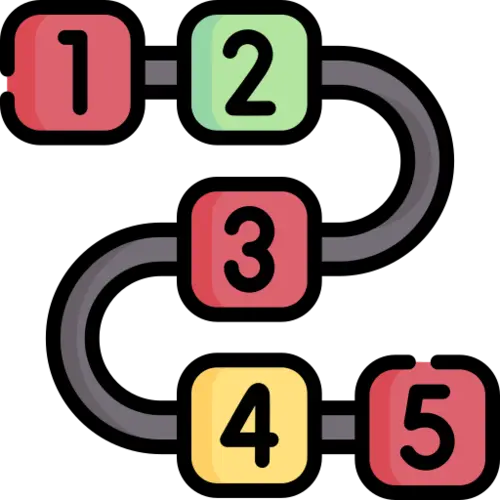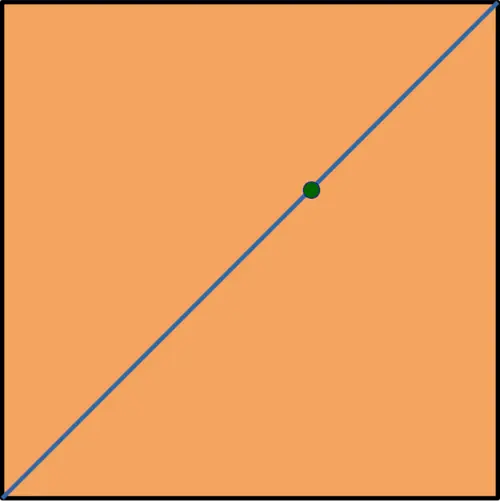Sequence and Series

This lecture note on Sequences and Series is designed for advanced high school students preparing for competitive examinations.
- introduces arithmetic sequences, including their general form, sum of terms, arithmetic mean, and solved problems.
- covers geometric sequences, their sum, geometric mean, and solved problems.
- discusses harmonic sequences, the sum of harmonic series, harmonic mean, and solved problems.
- explains Σ notation, a compact and systematic way to represent sums of series.
- describes the Vn-method, a useful technique for calculating series.
- presents the difference method for finding the sum of series.
- explores the arithmetic–geometric sequence and related results.
Arithmetic Sequence and Series
An arithmetic sequence (also called an arithmetic progression) is a list of numbers in which each term is obtained from the previous one by adding or subtracting a fixed number, called the common difference.
Examples of arithmetic sequences include:
- 2, 5, 8, 11, 14, … (common difference = 3)
- 100, 90, 80, 70, … (common difference = –10)
A sequence \( T_1, T_2, T_3, T_4, \ldots, T_n \) is an arithmetic sequence if
\[ T_2 - T_1 = T_3 - T_2 = \cdots = T_n - T_{n-1} = d \]where \(d\) is the common difference.
If the first term is \(T_1 = a\), then the \(n^{th}\) term is given by:
\[ T_n = a + (n-1)d \]The sum of the first \(n\) terms of an arithmetic sequence is denoted by \(S_n\). Note that
\[ T_n = S_n - S_{n-1} \]If the \(p^{th}\) term of an arithmetic sequence is \(q\) and the \(q^{th}\) term is \(p\), find the \((pq)^{th}\) term.
Given \[ T_p = a + (p-1)d = q \quad (i) \] \[ T_q = a + (q-1)d = p \quad (ii) \] From \((i)\) and \((ii)\), \[ pd - qd = q - p \] \[ (p-q)d = (q-p) \quad \Rightarrow \quad d = -1 \] From \((i)\), \[ a - q + 1 = p \quad \Rightarrow \quad a = p+q-1 \] Now, \[ T_{pq} = a + (pq-1)d \] \[ = (p+q-1) + (pq-1)(-1) \] \[ = p+q-1 - pq + 1 = p+q - pq \]
Sum of any two terms of an arithmetic series which are equidistant from both ends are equal.
Consider an arithmetic series \[ a,\; a+d,\; a+2d,\; \ldots,\; a+(n-1)d \] Sum of equidistant terms are \[ T_1 + T_n = a + \big(a + (n-1)d\big) = 2a + (n-1)d \] \[ T_2 + T_{n-1} = (a+d) + \big(a + (n-2)d\big) = 2a + (n-1)d \] \[ T_3 + T_{n-2} = (a+2d) + \big(a + (n-3)d\big) = 2a + (n-1)d \] \[ \vdots \] \[ T_k + T_{n-k+1} = 2a + (n-1)d \quad \forall\; k \] Therefore, the sum of any two terms equidistant from the ends is constant and equals \(2a+(n-1)d\).
Adding or subtracting a constant to an arithmetic sequence results in another arithmetic sequence.
Let the arithmetic sequence be \[ a, \; a+d, \; a+2d, \; \ldots, \; a+(n-1)d \] Add a constant \(k\) to each term \[ (a+k), \; (a+d+k), \; (a+2d+k), \; \ldots, \; (a+(n-1)d+k) \] The new sequence still satisfies the definition of arithmetic series, since \[ [(a+(n-1)d+k) - (a+(n-2)d+k)] = d \] Similarly, subtracting a constant \(k\) gives \[ (a-k), \; (a+d-k), \; (a+2d-k), \; \ldots, \; (a+(n-1)d-k) \] Again, the new sequence satisfies the definition of arithmetic series, since \[ [(a+(n-1)d-k) - (a+(n-2)d-k)] = d \]
Multiplying or dividing an arithmetic sequence by a constant results in another arithmetic sequence.
Let the arithmetic sequence be \[ a, \; a+d, \; a+2d, \; \ldots, \; a+(n-1)d \] Multiply each term by a constant \(k\): \[ ka, \; k(a+d), \; k(a+2d), \; \ldots, \; k(a+(n-1)d) \] The common difference becomes \[ [k(a+(r+1)d) - k(a+rd)] = kd \] which is constant, hence the new sequence is arithmetic. Similarly, dividing each term by a nonzero constant \(k\) gives \[ \frac{a}{k}, \; \frac{a+d}{k}, \; \frac{a+2d}{k}, \; \ldots, \; \frac{a+(n-1)d}{k} \] with common difference \[ \frac{(a+(r+1)d)}{k} - \frac{(a+rd)}{k} = \frac{d}{k} \] which is also constant. Thus, the result is an arithmetic sequence.
If \( \frac{b+c}{a}, \; \frac{c+a}{b}, \; \frac{a+b}{c} \) is an arithmetic sequence, then prove that \( \frac{1}{a}, \; \frac{1}{b}, \; \frac{1}{c} \) is also an arithmetic sequence, provided \(a+b+c \neq 0\).
Given \[ \frac{b+c}{a} + 1 = \frac{a+b+c}{a}, \quad \frac{c+a}{b} + 1 = \frac{a+b+c}{b}, \quad \frac{a+b}{c} + 1 = \frac{a+b+c}{c} \] Hence \[ \frac{a+b+c}{a}, \; \frac{a+b+c}{b}, \; \frac{a+b+c}{c} \; \text{is an arithmetic sequence.} \] Divide through by \((a+b+c) \neq 0\): \[ \frac{1}{a}, \; \frac{1}{b}, \; \frac{1}{c} \; \text{is an arithmetic sequence.} \]
If \( \frac{b+c-a}{a}, \; \frac{c+a-b}{b}, \; \frac{a+b-c}{c} \) is an arithmetic sequence, prove that \( \frac{1}{a}, \; \frac{1}{b}, \; \frac{1}{c} \) is also an arithmetic sequence.
Start with the given sequence: \[ \frac{b+c-a}{a}, \; \frac{c+a-b}{b}, \; \frac{a+b-c}{c} \] Add 1 to each term. This transforms the sequence into: \[ \frac{a+b+c}{a}, \; \frac{a+b+c}{b}, \; \frac{a+b+c}{c} \] Since adding the same constant to each term of a sequence preserves the arithmetic property, this is also an arithmetic sequence. Now, divide each term by \((a+b+c)\): \[ \frac{1}{a}, \; \frac{1}{b}, \; \frac{1}{c} \] Dividing by a nonzero constant also preserves the arithmetic property. Therefore, \(\tfrac{1}{a}, \tfrac{1}{b}, \tfrac{1}{c}\) is an arithmetic sequence.
Let \(a_1, a_2, \ldots, a_n\) be an arithmetic sequence. Prove that
\[ \frac{1}{a_1a_2} + \frac{1}{a_2a_3} + \frac{1}{a_3a_4} + \ldots + \frac{1}{a_{n-1}a_n} = \frac{n-1}{a_1a_n} \]Start with the sum: \[ \frac{1}{a_1a_2} + \frac{1}{a_2a_3} + \cdots + \frac{1}{a_{n-1}a_n} \] Notice that in an arithmetic sequence, the difference between consecutive terms is \(d\), i.e., \[ a_{k+1} - a_k = d \] Multiply and divide each term by this difference: \[ = \frac{1}{d}\left(\frac{a_2-a_1}{a_1a_2} + \frac{a_3-a_2}{a_2a_3} + \cdots + \frac{a_n-a_{n-1}}{a_{n-1}a_n}\right) \] Simplify each fraction: \[ = \frac{1}{d}\left(\frac{1}{a_1} - \frac{1}{a_2} + \frac{1}{a_2} - \frac{1}{a_3} + \cdots + \frac{1}{a_{n-1}} - \frac{1}{a_n}\right) \] This is a telescoping series where intermediate terms cancel, leaving: \[ = \frac{1}{d}\left(\frac{1}{a_1} - \frac{1}{a_n}\right) \] Combine into a single fraction: \[ = \frac{a_n-a_1}{da_1a_n} \] But since \(a_n = a_1+(n-1)d\), we get \[ a_n - a_1 = (n-1)d \] Substituting this, \[ = \frac{(n-1)d}{da_1a_n} = \frac{n-1}{a_1a_n} \]\
If \(a_1,a_2,\ldots,a_n\) is an arithmetic sequence, prove that
\[ \frac{1}{\sqrt{a_1}+\sqrt{a_2}} + \frac{1}{\sqrt{a_2}+\sqrt{a_3}} + \cdots + \frac{1}{\sqrt{a_{n-1}}+\sqrt{a_n}} = \frac{n-1}{\sqrt{a_1}+\sqrt{a_n}} \]Start with the given sum: \[ \frac{1}{\sqrt{a_1}+\sqrt{a_2}}+\frac{1}{\sqrt{a_2}+\sqrt{a_3}}+\ldots+\frac{1}{\sqrt{a_{n-1}}+\sqrt{a_n}} \] Multiply numerator and denominator of each term by the difference of the square roots. Since \(a_{k+1}-a_k = d\), \[ = \frac{1}{d}\Bigg[\frac{a_2-a_1}{\sqrt{a_1}+\sqrt{a_2}}+\frac{a_3-a_2}{\sqrt{a_2}+\sqrt{a_3}}+\ldots+\frac{a_n-a_{n-1}}{\sqrt{a_{n-1}}+\sqrt{a_n}}\Bigg] \] Simplify each fraction using \(a_{k+1}-a_k = (\sqrt{a_{k+1}}-\sqrt{a_k})(\sqrt{a_{k+1}}+\sqrt{a_k})\): \[ = \frac{1}{d}\Big[(\sqrt{a_2}-\sqrt{a_1})+(\sqrt{a_3}-\sqrt{a_2})+\ldots+(\sqrt{a_n}-\sqrt{a_{n-1}})\Big] \] This telescopes to: \[ = \frac{1}{d}(\sqrt{a_n}-\sqrt{a_1}) \] Multiply numerator and denominator by \(\sqrt{a_n}+\sqrt{a_1}\): \[ = \frac{1}{d}\frac{a_n-a_1}{\sqrt{a_n}+\sqrt{a_1}} \] Substituting \(a_n-a_1 = (n-1)d\), \[ = \frac{n-1}{\sqrt{a_1}+\sqrt{a_n}} \]
Sum of an arithmetic series
The sum of the first \(n\) terms of an arithmetic sequence with first term \(a\) and common difference \(d\) is equal to \(\tfrac{n}{2}(a+l)\), where \(l\) is the last term.
Let the first term be \(a\) and common difference be \(d\).
The sum of the first \(n\) terms can be written as \[ S = a+(a+d)+(a+2d)+\ldots+(l-d)+l \quad (i) \] Writing the same series in reverse order: \[ S = l+(l-d)+(l-2d)+\ldots+(a+d)+a \quad (ii) \] Now, add \((i)\) and \((ii)\): \[ 2S = (a+l)+(a+l)+(a+l)+\ldots+(a+l)=n(a+l) \] Dividing both sides by 2 gives \[ S = \frac{n}{2}(a+l) \]
This formula can also be expressed in two alternative forms: \[ S = \frac{n}{2}\Big[2a+(n-1)d\Big] \] or \[ S = \frac{n}{2}\Big[2l-(n-1)d\Big] \]
Find the sum of the \(n^{th}\) term of the sequence \[ (1),\;(1+2+3),\;(1+2+3+4+5),\;\ldots \quad (\text{n}^{\text{th}} \text{ term}) \]
The last number in the \(n^{\text{th}}\) term is \[ T_n = 1 + (n-1)\cdot 2 = 2n-1 \] Thus, the \(n^{\text{th}}\) term is the sum of an arithmetic series with first term \(1\), last term \(2n-1\), and number of terms equal to \(2n-1\). Using the sum formula: \[ S_n = \frac{2n-1}{2}\big[2+(2n-2)\big] \] Simplify: \[ S_n = (2n-1)\cdot n \] \[ S_n = 2n^2-n \]
Find the sum of the series inside the \(n^{\text{th}}\) term of the sequence \[ (1),\;(2+3+4),\;(5+6+7+8+9),\;\ldots \quad (\text{n}^{\text{th}} \text{ bracket}) \]
Notice that each bracket contains an arithmetic series. In the \(n^{\text{th}}\) bracket, the last term of this series is \[ T = n^2 \] The number of terms in this series is \(2n-1\). Therefore, its sum is \[ S_n = \frac{2n-1}{2}\Big[2n^2-(2n-2)\Big] \] Simplifying gives \[ S_n = \frac{(2n-1)(2n^2-2n+2)}{2} \]
Arithmetic mean
The arithmetic mean (AM) of two numbers \(a, b\) is \[ \text{AM} = \frac{a + b}{2} \] More generally, for \(n\) numbers \(a_1, a_2, a_3, \ldots, a_n\): \[ \text{AM} = \frac{a_1 + a_2 + \cdots + a_n}{n} \]
If \(n\) arithmetic means \(\text{AM}_1, \text{AM}_2, \ldots, \text{AM}_n\) are inserted between two numbers \(a, b\), then they form an arithmetic sequence given by \[ \text{AM}_i = a + i\,d, \quad i = 1, 2, \ldots, n \] where the common difference is \[ d = \frac{b - a}{n + 1} \]
Prove that the sum of \(n\) arithmetic means \( AM_1, AM_2, \ldots, AM_n \) inserted between \(a\) and \(b\) is equal to \(n\) times the AM of \(a, b\).
Since the \(n\) arithmetic means form an arithmetic progression: \[ AM_k = a + k d \quad \text{for } k = 1, 2, \ldots, n \] The sum of these means is: \[ \sum_{k=1}^{n} AM_k = \sum_{k=1}^{n} (a + k d) \] Break into two parts: \[ = \sum_{k=1}^n a + \sum_{k=1}^n k d = na + d \sum_{k=1}^{n} k \] Since \[ \sum_{k=1}^{n} k = \frac{n(n+1)}{2}, \] we have \[ \sum_{k=1}^{n} AM_k = na + d \cdot \frac{n(n+1)}{2} \] Substituting \(d = \frac{b - a}{n+1}\): \[ \sum_{k=1}^{n} AM_k = na + \frac{b-a}{n+1} \cdot \frac{n(n+1)}{2} \] Simplify: \[ = na + \frac{n(b - a)}{2} \] \[ = \frac{2na + n(b - a)}{2} \] \[ = \frac{n(a+b)}{2} \] \[ = n \cdot \frac{a+b}{2} \] Thus, the sum of the \(n\) arithmetic means equals \(n\) times the arithmetic mean of \(a\) and \(b\).
Geometric sequence and series
A sequence \(T_1, T_2,\ldots,T_n\) is a geometric sequence if the ratio between successive terms remains constant, i.e., for some \(r \in \mathbb{R}\), \[ \frac{T_{i+1}}{T_i}=r,\;\forall i\geq 1 \]
Let \(a\) be the first term and \( r \) be the common ratio. Then, the geometric sequence is given by
\[ T_1 = a = ar^{0}, \quad T_2 = ar = ar^{1}, \quad T_3 = ar^{2}, \quad \ldots, \quad T_n = ar^{n-1} \]Prove that the product of any two terms in a geometric sequence, equidistant from both ends, is a constant.
Consider the sequence \[ a, \; ar, \; ar^2, \; \ldots, \; ar^{n-1}. \] The \(k^{\text{th}}\) term from the beginning is \[ T_k = ar^{k-1}. \] The \(k^{\text{th}}\) term from the end is \[ T_{n-k+1} = ar^{n-k}. \] Their product is \[ T_k \cdot T_{n-k+1} = \big(ar^{k-1}\big)\big(ar^{n-k}\big) = a^2 r^{n-1}. \] This expression is independent of \(k\), hence constant. Therefore, the product of any two terms equidistant from both ends is the same.
If all terms of a geometric sequence are squared or raised to any power, multiplied or divided by a constant, prove that the resulting sequence will also be a geometric sequence.
Let the original geometric sequence be
\[
a, \; ar, \; ar^2, \; \ldots, \; ar^{n-1}.
\]
Case 1: Squaring or raising to a power
Squaring gives
\[
a^2, \; (ar)^2, \; (ar^2)^2, \ldots = a^2, \; a^2r^2, \; a^2r^4, \ldots
\]
The new common ratio is \(r^2\).
More generally, raising to power \(m\) gives common ratio \(r^m\).
Case 2: Multiplying by a constant \(k\)
\[
ka, \; kar, \; kar^2, \ldots
\]
The ratio remains \(r\).
Case 3: Dividing by a constant \(k \ne 0\)
\[
\tfrac{a}{k}, \; \tfrac{ar}{k}, \; \tfrac{ar^2}{k}, \ldots
\]
The ratio is again \(r\).
Thus, in all cases, the new sequence remains geometric.
Sum of a geometric series
The sum of the first \( n \) terms of a geometric series is equal to \[ S_n = \frac{a(1 - r^n)}{1 - r}, \quad r \ne 1. \]
The sum of first \(n\) terms of a geometric series is \[ S_n = a + ar + ar^2 + \cdots + ar^{n-1}. \] Multiply both sides by \(r\): \[ rS_n = ar + ar^2 + ar^3 + \cdots + ar^n. \] Subtract the two equations: \[ S_n - rS_n = a - ar^n. \] Factor: \[ S_n(1 - r) = a(1 - r^n). \] Hence, \[ S_n = \frac{a(1 - r^n)}{1 - r}, \quad r \ne 1. \]
If \( |r| < 1 \), the sum of an infinite geometric series converges to \[ S_{\infty} = \frac{a}{1 - r} \]
From , we have \[ S_n = \frac{a(1 - r^n)}{1 - r}, \quad r \neq 1 \]
As \( n \to \infty \): \[ \lim_{n \to \infty} r^n = 0 \quad \text{when } |r| < 1 \] Therefore, \[ S_{\infty} = \lim_{n \to \infty} S_n = \frac{a(1 - 0)}{1 - r} = \frac{a}{1 - r} \]
Geometric mean
The geometric mean between two numbers \(a, b \geq 0\) is given by \[ \text{GM} = \sqrt{ab} \] For \(n\) numbers \(a_1, a_2, a_3, \ldots, a_n \geq 0\), the GM is given by \[ \text{GM} = \sqrt[n]{a_1 a_2 \cdots a_n} \]
If \(n\) geometric means are inserted between two numbers \(a\) and \(b\), they form a geometric sequence. These means are given by \[ \text{GM}_i = ar^i, \quad i = 1, 2, \ldots, n \] where the common ratio is \[ r = \left( \frac{b}{a} \right)^{\frac{1}{n+1}} \]
Prove that the product of \(n\) geometric means between \(a\) and \(b\) is equal to the \(n\)th power of the single geometric mean between \(a\) and \(b\).
Let the \(n\) geometric means be \(g_1, g_2, \ldots, g_n\). By definition, \[ g_1 \cdot g_2 \cdot \ldots \cdot g_n = (ar)(ar^2)\cdots(ar^n) \] Simplify: \[ = a^n \cdot r^{1+2+\cdots+n} = a^n \cdot r^{\frac{n(n+1)}{2}} \] Substituting \( r = \left(\frac{b}{a}\right)^{\frac{1}{n+1}} \): \[ = a^n \cdot \left(\frac{b}{a}\right)^{\frac{n(n+1)}{2(n+1)}} \] \[ = a^n \cdot \left(\frac{b}{a}\right)^{\frac{n}{2}} \] \[ = (ab)^{\frac{n}{2}} \] But the geometric mean between \(a\) and \(b\) is \(\sqrt{ab}\). Therefore, the product of the \(n\) geometric means is \[ (\sqrt{ab})^n \] which proves the result.
If \(1 + x + x^2 + x^3 + \cdots \infty\) is equal to \(a\), and \(1 + y + y^2 + \cdots \infty\) is equal to \(b\), then find \(1 + xy + x^2y^2 + x^3y^3 + \cdots \infty\) in terms of \(a\) and \(b\).
Let \[ S = 1 + xy + x^2y^2 + x^3y^3 + \cdots \] Multiply by \(xy\): \[ xyS = xy + x^2y^2 + x^3y^3 + \cdots \] Subtract: \[ S - xyS = 1 \quad \Rightarrow \quad S = \frac{1}{1-xy} \] From the given conditions: \[ \frac{1}{1-x} = a \quad \Rightarrow \quad x = \frac{a-1}{a} \] \[ \frac{1}{1-y} = b \quad \Rightarrow \quad y = \frac{b-1}{b} \] Substituting: \[ S = \frac{1}{1 - \frac{(a-1)(b-1)}{ab}} \] Simplify: \[ S = \frac{ab}{a+b-1} \]
Simplify \(a + b + a^2 + b^2 + (a^3 + b^3) + \cdots \infty\).
Grouping terms: \[ a + b + a^2 + b^2 + a^3 + b^3 + \cdots = (a + a^2 + a^3 + \cdots) + (b + b^2 + b^3 + \cdots) \] Each group is a geometric series: \[ = \frac{a}{1-a} + \frac{b}{1-b}, \quad \text{for } |a|<1, |b|<1 \]
Harmonic sequence and series
A sequence \(T_1, T_2, \ldots, T_n\) is a harmonic sequence if \(\tfrac{1}{T_1}, \tfrac{1}{T_2}, \ldots, \tfrac{1}{T_n}\) is an arithmetic sequence ().
The \(n^{\text{th}}\) term of a harmonic sequence is given by \[ T_n = \frac{1}{a + (n-1)d} \] where \(a\) is the first term of the corresponding arithmetic sequence and \(d\) is its common difference.
Sum of a harmonic series
There is no simple closed form expression for the sum of a harmonic series.
Harmonic mean
The harmonic mean of two numbers \(a, b\) is given by \[ \text{HM} = \frac{2ab}{a+b} \] For \(n\) numbers \(a_1, a_2, \ldots, a_n\), the harmonic mean is \[ \text{HM} = \frac{n}{\tfrac{1}{a_1} + \tfrac{1}{a_2} + \cdots + \tfrac{1}{a_n}} \]
If \(n\) harmonic means are inserted between two numbers \(a\) and \(b\), then \[ H_k = \frac{1}{\dfrac{1}{a} + \dfrac{k}{n+1}\Bigl(\dfrac{1}{b} - \dfrac{1}{a}\Bigr)}, \quad k=1,2,\ldots,n \]
If \(a, H_1, H_2, \ldots, H_n, b\) is a harmonic sequence, then \[ \frac{1}{a}, \frac{1}{H_1}, \frac{1}{H_2}, \ldots, \frac{1}{H_n}, \frac{1}{b} \] is an arithmetic sequence. Therefore, \[ \frac{1}{H_k} = \frac{1}{a} + \frac{k}{n+1}\left(\frac{1}{b} - \frac{1}{a}\right), \quad k=1,2,\ldots,n \] which simplifies to the formula for \(H_k\).
If \(a_1, a_2, a_3, \ldots, a_n\) is a harmonic sequence, show that \[ a_1 a_2 + a_2 a_3 + a_3 a_4 + \cdots + a_{n-1}a_n = (n-1)a_1 a_n \]
Since \(a_1, a_2, \ldots, a_n\) is a harmonic sequence, their reciprocals form an arithmetic sequence. Let the common difference be \(d\). \[ d = \frac{\tfrac{1}{a_n} - \tfrac{1}{a_1}}{n-1} = \frac{a_1 - a_n}{a_1 a_n (n-1)} \] For each pair of consecutive terms: \[ \frac{1}{a_2} - \frac{1}{a_1} = d, \quad \frac{1}{a_3} - \frac{1}{a_2} = d, \quad \ldots, \quad \frac{1}{a_n} - \frac{1}{a_{n-1}} = d \] Rearranging: \[ a_1 - a_2 = d a_1 a_2, \quad a_2 - a_3 = d a_2 a_3, \quad \ldots, \quad a_{n-1} - a_n = d a_{n-1}a_n \] Summing these equations: \[ (a_1 - a_n) = d \bigl(a_1a_2 + a_2a_3 + \cdots + a_{n-1}a_n\bigr) \] Substituting the value of \(d\): \[ a_1 - a_n = \frac{a_1 - a_n}{a_1 a_n (n-1)} \cdot (a_1a_2 + a_2a_3 + \cdots + a_{n-1}a_n) \] Cancelling \((a_1 - a_n)\) (assuming it is non-zero): \[ (n-1)a_1a_n = a_1a_2 + a_2a_3 + \cdots + a_{n-1}a_n \] which is the required result.
Σ notation for summation
We use \(\Sigma\) notation to concisely represent summation of a series. Let's define it formally:
\[ \sum_{x=a}^{b} f(x) = f(a) + f(a+1) + \dots + f(b-1) + f(b) \]
\[ \sum_{x=a}^{b} f(x) = \sum_{x=a}^{b} f(a+b-x) \]
If \(a\) and \(b\) do not have any common factor, prove that \[ \sum_{r=1}^{b-1} \left\lfloor\frac{ar}{b}\right\rfloor = \frac{(a-1)(b-1)}{2} \] Here, \(\lfloor\cdot\rfloor\) denotes the floor function.
Let \[ A = \sum_{r=1}^{b-1} \left\lfloor\frac{ar}{b}\right\rfloor \] Using , we can write \[ A = \sum_{r=1}^{b-1} \left\lfloor \frac{a(b-r)}{b} \right\rfloor \] Simplify: \[ A = \sum_{r=1}^{b-1} \left\lfloor a - \frac{ar}{b} \right\rfloor \] Since \(a\) is integer, this becomes \[ A = \sum_{r=1}^{b-1} \left(a + \left\lfloor -\tfrac{ar}{b} \right\rfloor\right) \] Adding the two expressions for \(A\): \[ 2A = \sum_{r=1}^{b-1} \left(a + \left\lfloor -\tfrac{ar}{b} \right\rfloor + \left\lfloor \tfrac{ar}{b} \right\rfloor\right) \] By the property of floor function, \(\left\lfloor -x \right\rfloor + \left\lfloor x \right\rfloor = -1\) (when \(x\) is not integer). Since \(\tfrac{ar}{b}\) is not integer (as \(a,b\) are coprime), we have \[ 2A = \sum_{r=1}^{b-1} (a-1) \] Therefore \[ 2A = (b-1)(a-1) \quad \Rightarrow \quad A = \frac{(b-1)(a-1)}{2} \]
\[ \sum_{r=1}^{n} 1 = n \] \[ \sum_{r=1}^{n} r = \frac{n(n+1)}{2} \] \[ \sum_{r=1}^{n} r^2 = \frac{n(n+1)(2n+1)}{6} \] \[ \sum_{r=1}^{n} r^3 = \left( \frac{n(n+1)}{2} \right)^2 \] \[ \sum_{r=1}^{n} a r = a \sum_{r=1}^{n} r \] If the \(n\)-th term of a series is \(an^3 + bn^2 + cn + d\), then \[ \sum (an^3 + bn^2 + cn + d) = a \sum n^3 + b \sum n^2 + c \sum n + d \sum 1 \]
Calculate \[ S = (1 \times 2) + (2 \times 3) + (3 \times 4) + \cdots \ \text{upto \(n\) terms} \]
Calculate \[ S = (2 \times 3 \times 4) + (3 \times 4 \times 5) + \cdots \ \text{upto \(n\) terms} \]
Calculate \[ S = (1 \cdot 3) + (3 \cdot 5) + (5 \cdot 7) + \cdots \ \text{upto \(n\) terms} \]
Vn method for calculating sum of a series
Calculate the sum of the series \(2 \cdot 3 \cdot 4 \cdot 5 \cdot 6 \cdot 7 \cdot 8 + 3 \cdot 4 \cdot 5 \cdot 6 \cdot 7 \cdot 8 \cdot 9 + \ldots \) up to \(n\) terms
The general term is \[ T_n = (n+1)(n+2)(n+3)(n+4)(n+5)(n+6)(n+7) \] To apply the \(V_n\) method, we define \[ V_n = (n+1)(n+2)(n+3)(n+4)(n+5)(n+6)(n+7)(n+8) \] Then \[ V_{n-1} = n(n+1)(n+2)(n+3)(n+4)(n+5)(n+6)(n+7) \] Subtracting, \[ V_n - V_{n-1} = (n+1)(n+2)\cdots(n+7)\,(n+8-n) \] \[ \Rightarrow V_n - V_{n-1} = 8T_n \] Hence, \[ T_n = \frac{V_n - V_{n-1}}{8} \] This gives a telescoping series: \[ S_n = \frac{1}{8}(V_n - V_0) \] Therefore, \[ S_n= \frac{1}{8} \Big[(n+1)(n+2)\cdots(n+8) - 1\cdot2\cdot3\cdot4\cdot5\cdot6\cdot7\cdot8\Big] \]
Calculate the sum of the series \(1 \cdot 3 \cdot 5 \cdot 7 \cdot 9 + 3 \cdot 5 \cdot 7 \cdot 9 \cdot 11 + \ldots \) up to \(n\) terms
The general term is \[ T_n = (2n-1)(2n+1)(2n+3)(2n+5)(2n+7) \] Define \[ V_n = (2n-1)(2n+1)(2n+3)(2n+5)(2n+7)(2n+9) \] Then \[ V_{n-1} = (2n-3)(2n-1)(2n+1)(2n+3)\cdots(2n+7) \] So, \[ V_n - V_{n-1} = (2n-1)(2n+1)(2n+3)\cdots(2n+7)\,[(2n+9) - (2n-3)] \] \[ \Rightarrow V_n - V_{n-1} = 12T_n \] Hence, \[ T_n = \frac{V_n - V_{n-1}}{12} \] Summing telescopically, \[ S_n = \frac{1}{12}(V_n - V_0) \] So, \[ S_n = \frac{1}{12}\Big[(2n-1)(2n+1)(2n+3)\cdots(2n+9) - 1 \cdot 3 \cdot 5 \cdot 7 \cdot 9 \Big] \]
Calculate the sum of the series \(\dfrac{1}{1 \cdot 2 \cdot 3 \cdot 4 \cdot 5} + \dfrac{1}{2 \cdot 3 \cdot 4 \cdot 5 \cdot 6} + \ldots \) up to \(n\) terms
The general term is \[ T_n = \frac{1}{n(n+1)(n+2)(n+3)(n+4)} \] Define \[ V_n = \frac{1}{(n+1)(n+2)(n+3)(n+4)} \] Then \[ V_{n-1} = \frac{1}{n(n+1)(n+2)(n+3)} \] Subtract: \[ V_n - V_{n-1} = \frac{n-(n+4)}{n(n+1)(n+2)(n+3)(n+4)} = -4T_n \] So, \[ T_n = \frac{V_{n-1} - V_n}{4} \] The series telescopes: \[ S_n = \frac{1}{4}(V_0 - V_n) \] As \(n \to \infty\), \[ S_\infty = \frac{1}{4}V_0 = \frac{1}{4 \cdot (1\cdot2\cdot3\cdot4)} = \frac{1}{96} \]
Calculate the sum of the series \[ \frac{1}{2 \cdot 3 \cdot 4 \cdot 5} + \frac{1}{3 \cdot 4 \cdot 5 \cdot 6} + \ldots \quad \text{up to \(n\) terms} \]
The general term is \[ T_n = \frac{1}{(n+1)(n+2)(n+3)(n+4)} \] Define \[ V_n = \frac{1}{(n+2)(n+3)(n+4)} \] Then \[ V_{n-1} = \frac{1}{(n+1)(n+2)(n+3)} \] Subtract: \[ V_n - V_{n-1} = \frac{(n+1)-(n+4)}{(n+1)(n+2)(n+3)(n+4)} = -3T_n \] So, \[ T_n = \frac{V_{n-1} - V_n}{3} \] By telescoping, \[ S_n = \frac{1}{3}(V_0 - V_n) = \frac{1}{3}\left(\frac{1}{2\cdot3\cdot4} - \frac{1}{(n+2)(n+3)(n+4)}\right) \] As \(n \to \infty\), \[ S_\infty = \frac{1}{3}V_0 = \frac{1}{3 \cdot (2\cdot3\cdot4)} = \frac{1}{72} \]
Find the sum of product of first \(n\) natural numbers taking 2 at a time, using permutation and combination, i.e., \[ S_n = (1 \cdot 2) + (1 \cdot 3) + (1 \cdot 4) + \ldots + (1 \cdot n) + (2 \cdot 3) + (2 \cdot 4) + \ldots + (2 \cdot n) + \ldots + ((n-1)\cdot n) \]
We use the identity \[ (a+b+c+d)^2 = a^2+b^2+c^2+d^2 + 2(ab+ac+ad+bc+bd+cd) \] This shows that the cross-product sum can be extracted from the square of the sum.
Applying this to the first \(n\) natural numbers: \[ (1+2+3+\ldots+n)^2 = (1^2+2^2+3^2+\ldots+n^2) + 2S_n \]
Rearranging, \[ S_n = \frac{(1+2+3+\ldots+n)^2 - (1^2+2^2+3^2+\ldots+n^2)}{2} \]
Thus in summation form, \[ S_n = \frac{\Big(\sum n\Big)^2 - \sum n^2}{2} \]
Calculate the sum of the series \[ 1^2 - 2^2 + 3^2 - 4^2 + 5^2 - 6^2 + \ldots \quad \text{up to \(2n\) terms} \]
Method 1: Separate into odd and even squares. \[ S_n = \Big[1^2 + 3^2 + 5^2 + \ldots + (2n-1)^2\Big] - \Big[2^2 + 4^2 + \ldots + (2n)^2\Big] \]
That is, \[ S_n = \sum (2n-1)^2 - \sum (2n)^2 \]
Method 2: Group as pairs. \[ S_n = (1-2)(1+2) + (3-4)(3+4) + \ldots + (2n-1)(2n+1) \] Each bracket simplifies to a negative consecutive sum, giving \[ \Rightarrow S_n = -(1+2+3+\ldots+2n) \]
Finally, \[ S_n = -2n(2n+1)/2 = -n(2n+1) \]
Calculate the sum of the series \[ 1^2 - 3 \cdot 2^2 + 3^2 - 3 \cdot 4^2 + 5^2 - 3 \cdot 6^2 + \ldots \quad \text{up to \(2n\) terms} \]
Method 1: Write the general term. \[ T_n = (2n-1)^2 - 3(2n)^2 = (4n^2 - 4n + 1) - 12n^2 = -8n^2 - 4n + 1 \]
Summing, \[ S_n = \sum_{i=1}^n \big[(2i-1)^2 - 3(2i)^2\big] = \sum_{i=1}^n (2i-1)^2 - 3\sum_{i=1}^n (2i)^2 \]
Method 2: Split into two series. \[ S_n = \Big(1^2+2^2+3^2+\ldots+(2n)^2\Big) - 4\Big(2^2+4^2+6^2+\ldots+(2n)^2\Big) \]
So, \[ S_n = \sum_{r=1}^{2n} r^2 - 4\sum_{r=1}^{n} (2r)^2 \] \[ \Rightarrow S_n = \sum_{r=1}^{2n} r^2 - 16\sum_{r=1}^{n} r^2 \]
Difference method for calculating sum of a series
Calculate \[ S=1 + 2 + 4 + 7 + 11 + 16 + \ldots \quad n \text{ terms} \]
Note that \[ S=1 + 2 + 4 + 7 + 11 + 16 + \ldots \quad n \text{ terms} \] and shifting by one term, \[ S=\quad\quad 1 + 2 + 4 + 7 + 11 + 16 + \ldots \quad n \text{ terms} \]
Subtracting the two gives \[ 0 = 1 + (1+2+3+4+\ldots+(n-1)) - T_n \] where \(T_n\) is the \(n\)th term.
Thus \[ T_n = 1 + \frac{n^2}{2} - \frac{n}{2} \] and hence \[ S_n = n + \frac{1}{2}\sum n^2 - \frac{1}{2}\sum n \]
Calculate \[ S=1 + 3 + 6 + 10 + 15 + \ldots \quad \text{n terms} \]
Note that \[ S=1 + 3 + 6 + 10 + 15 + \ldots \quad \text{n terms} \] and shifting, \[ S=\quad\quad 1 + 3 + 6 + 10 + 15 + \ldots \quad \text{n terms} \]
Subtracting the two gives \[ 1 - T_n + 2 + 4 + \ldots + (n-1) = 0 \]
Hence \[ T_n = 1 + 2 + 3 + \ldots + n = \frac{n(n+1)}{2} \] and \[ S_n = \frac{1}{2}\sum n^2 + \frac{1}{2}\sum n \]
Arithmetic–geometric sequence
Calculate the sum of the series \[ 1x^0 + 2x + 3x^2 + \ldots \quad \text{n terms} \]
Let \[ S = 1 + 2x + 3x^2 + \ldots + (n-1)x^{n-2} + nx^{n-1} \] Multiplying by \(x\), \[ xS = x + 2x^2 + 3x^3 + \ldots + (n-1)x^{n-1} + nx^n \] Subtracting, \[ S(1-x) = 1 + x + x^2 + \ldots + x^{n-1} - nx^n \]
The geometric sum gives \[ S(1-x) = \frac{1 - x^n}{1-x} - nx^n \] so \[ S = \frac{1 - x^n}{(1-x)^2} - \frac{nx^n}{1-x} \]
Calculate \[ S=x + 3x^2 + 5x^3 + \ldots \quad \text{n terms} \]
Multiplying by \(x\), \[ xS = x^2 + 3x^3 + 5x^4 + \ldots + (2n-1)x^{n+1} \] Subtracting, \[ S(1-x) = x + 2x^2 + 2x^3 + \ldots + 2x^n - (2n-1)x^{n+1} \]
So \[ S(1-x) = x + \frac{2x^2(1-x^{n-1})}{1-x} - (2n-1)x^{n+1} \] \[ \Rightarrow S_n = \frac{x}{1-x} + \frac{2x^2(1-x^{n-1})}{(1-x)^2} - \frac{(2n-1)x^{n+1}}{1-x} \]
For \(n\to\infty\) (with \(|x|<1\)), \[ S_\infty = \frac{x}{1-x} + \frac{2x^2}{(1-x)^2} \]
Calculate \[ S = 1^2x + 2^2x^2 + 3^2x^3 + 4^2x^4 + \cdots + n^2x^n \]
Multiplying by \(x\), \[ xS = 1^2x^2 + 2^2x^3 + 3^2x^4 + \cdots + n^2x^{n+1} \] Subtracting, \[ S(1-x) = S' - n^2x^{n+1} \quad (i) \] where \[ S' = x + 3x^2 + 5x^3 + \cdots + (2n-1)x^n + n^2x^n \]
Now, \[ xS' = x^2 + 3x^3 + 5x^4 + \cdots + (2n-1)x^{n+1} \] Subtracting, \[ S'(1-x) = x + 2x^2 + 2x^3 + \cdots + 2x^n - (2n-1)x^{n+1} \] \[ \Rightarrow S' = \frac{x}{1-x} + \frac{2x^2(1-x^n)}{(1-x)^2} - \frac{(2n-1)x^{n+1}}{1-x} \]
Finally, substitute \(S'\) into equation (i) to obtain the expression for \(S\).
Relation between AM, GM, and HM
\[ AM \geq GM \geq HM \quad (a,b \in \mathbb{R}^+) \]
\[ AM = \frac{a+b}{2}, \quad GM = \sqrt{ab} \] \[ AM - GM = \frac{a+b}{2} - \sqrt{ab} = \frac{a+b - 2\sqrt{ab}}{2} = \frac{(\sqrt{a}-\sqrt{b})^2}{2} \geq 0 \] Hence, \[ AM \geq GM \] For harmonic mean, \[ HM = \frac{2ab}{a+b} \] Now, \[ GM - HM = \sqrt{ab} - \frac{2ab}{a+b} = \frac{\sqrt{ab}(a+b - 2\sqrt{ab})}{a+b} = \frac{\sqrt{ab}(\sqrt{a}-\sqrt{b})^2}{a+b} \geq 0 \] Hence, \[ GM \geq HM \] Therefore, \[ AM \geq GM \geq HM \] In general, for \(n\) positive terms: \[ \frac{a_1+a_2+\cdots+a_n}{n} \;\geq\; (a_1a_2\cdots a_n)^{1/n} \;\geq\; \frac{n}{\frac{1}{a_1}+\frac{1}{a_2}+\cdots+\frac{1}{a_n}} \]
Find the range of \(\dfrac{x+1}{x}, \; x \in \mathbb{R}^+\)
Using AM \(\geq\) GM: \[ \frac{x+\tfrac{1}{x}}{2} \geq 1 \quad\Rightarrow\quad x+\frac{1}{x} \geq 2 \] Hence, the range is \[ [2, \infty) \]
Find the range of \(\dfrac{x+1}{x}, \; x \in \mathbb{R}^- \)
For \(x<0\), write \[ \frac{x+1}{x} = 1 + \frac{1}{x} \] Since \(x<0\), we have \(\frac{1}{x}<0\), so \[ \frac{x+1}{x} \leq 1 \] and as \(x \to 0^-\), \(\frac{x+1}{x} \to -\infty\). Thus, the range is \[ (-\infty, 1) \]
Prove that \[ a^2 + b^2 + c^2 \geq ab + bc + ca, \quad a,b,c \in \mathbb{R}^+ \]
By AM \(\geq\) GM, \[ \frac{a^2+b^2}{2} \geq ab \quad (i) \] \[ \frac{b^2+c^2}{2} \geq bc \quad (ii) \] \[ \frac{c^2+a^2}{2} \geq ca \quad (iii) \] Adding \((i)+(ii)+(iii)\) gives \[ a^2+b^2+c^2 \geq ab+bc+ca \]
Prove that \[ a^4 + b^4 + c^4 \geq abc(a+b+c), \quad a,b,c \in \mathbb{R}^+ \]
First, note \[ a^4+b^4+c^4 \geq a^2b^2+b^2c^2+c^2a^2 \] Now, by AM–GM: \[ \frac{a^2b^2+a^2c^2}{2} \geq a^2bc \quad (i) \] \[ \frac{a^2b^2+b^2c^2}{2} \geq b^2ca \quad (ii) \] \[ \frac{b^2c^2+c^2a^2}{2} \geq c^2ab \quad (iii) \] Adding gives \[ a^2b^2+b^2c^2+c^2a^2 \geq a^2bc+b^2ca+c^2ab = abc(a+b+c) \] Hence, \[ a^4+b^4+c^4 \geq abc(a+b+c) \]
Let \(a,b,c \in \mathbb{R}^+\). Prove that \[ \frac{a+b}{c} + \frac{b+c}{a} + \frac{c+a}{b} \geq 6 \]
By AM \(\geq\) GM, \[ \frac{\tfrac{a}{c}+\tfrac{b}{c}+\tfrac{b}{a}+\tfrac{c}{a}+\tfrac{c}{b}+\tfrac{a}{b}}{6} \geq 1 \] Hence, \[ \frac{a+b}{c}+\frac{b+c}{a}+\frac{c+a}{b} \geq 6 \]
Let \(a,b,c,d,e,f \in \mathbb{R}^+\). Prove that \[ \left(\frac{a}{d}+\frac{b}{e}+\frac{c}{f}\right) \left(\frac{d}{b}+\frac{e}{c}+\frac{f}{a}\right) \geq 9 \]
Apply AM–GM to each product term. For example, \[ \frac{a}{d} \cdot \frac{d}{b} \geq 2\sqrt{\frac{a}{b}} \] Expanding all 9 terms, and applying AM–GM, gives \[ \left(\frac{a}{d}+\frac{b}{e}+\frac{c}{f}\right)\left(\frac{d}{b}+\frac{e}{c}+\frac{f}{a}\right) \geq 9 \]
If \(a+b+c = 5\), find the maximum value of \(abc\), where \(a,b,c \in \mathbb{R}^+\).
By AM–GM: \[ \frac{a+b+c}{3} \geq (abc)^{1/3} \] Substituting \(a+b+c=5\), \[ \frac{5}{3} \geq (abc)^{1/3} \] Cubing, \[ abc \leq \frac{125}{27} \]
If \(a+b+c=5\), find the maximum value of \(a^2 b^3 c^4\), where \(a,b,c \in \mathbb{R}^+\)
Write as: \[ \frac{a}{2}+\frac{a}{2}+\frac{b}{3}+\frac{b}{3}+\frac{b}{3}+\frac{c}{4}+\frac{c}{4}+\frac{c}{4}+\frac{c}{4} = 5 \] By AM–GM, \[ \frac{5}{9} \geq (a^2 b^3 c^4)^{1/9} \] Hence, \[ a^2 b^3 c^4 \leq \left(\frac{5}{9}\right)^9 \]
If \(3a+2b+c=5\), find the maximum value of \(a^2 b^3 c^4\), where \(a,b,c \in \mathbb{R}^+\)
Write as: \[ \frac{3a}{2}+\frac{3a}{2}+\frac{2b}{3}+\frac{2b}{3}+\frac{2b}{3}+\frac{c}{4}+\frac{c}{4}+\frac{c}{4}+\frac{c}{4} = 5 \] By AM–GM, \[ \frac{5}{9} \geq (a^2 b^3 c^4)^{1/9} \] Hence, \[ a^2 b^3 c^4 \leq \left(\frac{5}{9}\right)^9 \]
Evaluate \[ S = 1\cdot 2^2 \cdot 3 + 2\cdot 3^2 \cdot 4 + 3\cdot 4^2 \cdot 5 + \dots \]
General term: \[ T_n = n(n+1)(n+2)(n+1) \] Simplify: \[ T_n = \tfrac{1}{2}\,n(n+1)(n+2)(n+3) + \tfrac{1}{2}(n-1)n(n+1)(n+2) \] So the sum reduces to the sum of two polynomial series.
Author
Anurag Gupta is an M.S. graduate in Electrical and Computer Engineering from Cornell University. He also holds an M.Tech degree in Systems and Control Engineering and a B.Tech degree in Electrical Engineering from the Indian Institute of Technology, Bombay.
Comment
This policy contains information about your privacy. By posting, you are declaring that you understand this policy:
- Your name, rating, website address, town, country, state and comment will be publicly displayed if entered.
- Aside from the data entered into these form fields, other stored data about your comment will include:
- Your IP address (not displayed)
- The time/date of your submission (displayed)
- Your email address will not be shared. It is collected for only two reasons:
- Administrative purposes, should a need to contact you arise.
- To inform you of new comments, should you subscribe to receive notifications.
- A cookie may be set on your computer. This is used to remember your inputs. It will expire by itself.
This policy is subject to change at any time and without notice.
These terms and conditions contain rules about posting comments. By submitting a comment, you are declaring that you agree with these rules:
- Although the administrator will attempt to moderate comments, it is impossible for every comment to have been moderated at any given time.
- You acknowledge that all comments express the views and opinions of the original author and not those of the administrator.
- You agree not to post any material which is knowingly false, obscene, hateful, threatening, harassing or invasive of a person's privacy.
- The administrator has the right to edit, move or remove any comment for any reason and without notice.
Failure to comply with these rules may result in being banned from submitting further comments.
These terms and conditions are subject to change at any time and without notice.
Similar content





Past Comments